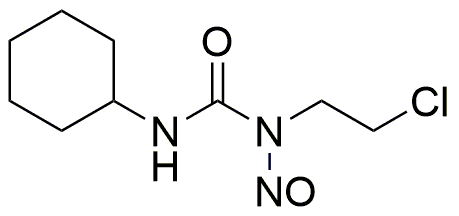Lomustine is widely utilized in research focused on
- Cancer Treatment: Primarily used as a chemotherapy agent for treating various types of cancers, including brain tumors and Hodgkin's lymphoma, offering targeted action against malignant cells.
- Veterinary Medicine: Employed in veterinary oncology for treating tumors in pets, providing an effective option for animal healthcare professionals.
- Research Applications: Utilized in laboratory settings to study the mechanisms of cancer cell resistance and the development of new therapeutic strategies, aiding researchers in understanding tumor biology.
- Combination Therapy: Often used in conjunction with other chemotherapeutic agents to enhance treatment efficacy, allowing for a more comprehensive approach to cancer management.
- Drug Development: Serves as a model compound in the development of new nitrosourea derivatives, facilitating advancements in cancer pharmacology and improving treatment outcomes.
General Information
Properties
Safety and Regulations
Applications
Lomustine is widely utilized in research focused on
- Cancer Treatment: Primarily used as a chemotherapy agent for treating various types of cancers, including brain tumors and Hodgkin's lymphoma, offering targeted action against malignant cells.
- Veterinary Medicine: Employed in veterinary oncology for treating tumors in pets, providing an effective option for animal healthcare professionals.
- Research Applications: Utilized in laboratory settings to study the mechanisms of cancer cell resistance and the development of new therapeutic strategies, aiding researchers in understanding tumor biology.
- Combination Therapy: Often used in conjunction with other chemotherapeutic agents to enhance treatment efficacy, allowing for a more comprehensive approach to cancer management.
- Drug Development: Serves as a model compound in the development of new nitrosourea derivatives, facilitating advancements in cancer pharmacology and improving treatment outcomes.
Documents
Safety Data Sheets (SDS)
The SDS provides comprehensive safety information on handling, storage, and disposal of the product.
Product Specification (PS)
The PS provides a comprehensive breakdown of the product’s properties, including chemical composition, physical state, purity, and storage requirements. It also details acceptable quality ranges and the product's intended applications.
Certificates of Analysis (COA)
Search for Certificates of Analysis (COA) by entering the products Lot Number. Lot and Batch Numbers can be found on a product’s label following the words ‘Lot’ or ‘Batch’.
Numéro de catalogue
Numéro de lot/série
Certificates Of Origin (COO)
This COO confirms the country where the product was manufactured, and also details the materials and components used in it and whether it is derived from natural, synthetic, or other specific sources. This certificate may be required for customs, trade, and regulatory compliance.
Numéro de catalogue
Numéro de lot/série
Safety Data Sheets (SDS)
The SDS provides comprehensive safety information on handling, storage, and disposal of the product.
DownloadProduct Specification (PS)
The PS provides a comprehensive breakdown of the product’s properties, including chemical composition, physical state, purity, and storage requirements. It also details acceptable quality ranges and the product's intended applications.
DownloadCertificates of Analysis (COA)
Search for Certificates of Analysis (COA) by entering the products Lot Number. Lot and Batch Numbers can be found on a product’s label following the words ‘Lot’ or ‘Batch’.
Numéro de catalogue
Numéro de lot/série
Certificates Of Origin (COO)
This COO confirms the country where the product was manufactured, and also details the materials and components used in it and whether it is derived from natural, synthetic, or other specific sources. This certificate may be required for customs, trade, and regulatory compliance.


